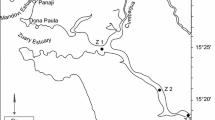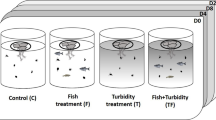Abstract
Grazing experiments were carried out in a limed lake (Lago d'Orta) during the periods, 23–24 March and 28–29 June 1990. A simple in situ technique based on cell counts before and after incubation was used in order to evaluate the impact of the natural zooplankton community on the lake phytoplankton. An estimation of the daily consumption by the natural zooplankton community showed that about 4.6% and 1.04% of the standing algal biomass was removed during March and June respectively. The differences in grazing activities were likely due to the difference in zooplankton community structure and to the surrounding environmental conditions, mainly influenced by the liming intervention, started in the lake water since 1989.
Similar content being viewed by others

References
Bogdan, K. G. & J. J. Gilbert, 1982. Seasonal patterns of feeding by natural populations of Keratella, Polyarthra and Bosmina: Clearance rate, selectivities and contributions to community grazing. Limnol. Oceanogr. 27: 918–934.
Bonacina, C., 1970. Il Lago di Orta, ulteriore evoluzione della situazione chimica e della struttura della biocenosi planctonica. Mem. Ist. ital. Idrobiol. 26: 141–204.
Bonacina, C., G. Bonomi, L. Barbanti, R. Mosello, D. Ruggiu & G. Tartari, 1988. Lake Orta (N. Italy): recovery after the adoption of restoration plans. In Schmidtke, N.W. (ed.), Toxic contamination in large lakes. (vol. II) Lewis Publishers, Inc. Chelsea, Michigan (USA).
Borsheim, K. Y. & S. Andersen, 1987. Grazing and food selection by crustacean zooplankton compaired to production of bacteria and phytoplankton in a shallow Norwegian mountain lake. J. Plankton Res. 9: 367–379.
Bottrell, H. H., A. Duncan, Z. M. Gliwicz, E. Grygierek, P. Larsson & T. Weglenska, 1976. A review of some problems in zooplankton studies. Norw. J. Zoopl. 24: 419–456.
Bums, C., 1969. Relation between filtering, temperature, and body size in four species of Daphnia. Limnol. Oceanogr. 14: 693–700.
Calderoni, A., R. Mosello & A. Quirci, 1991. Chemical response of Lake Orta (Northern Italy) to liming. Arch. Hydrobiol. 122: 421–439.
Castri', L., 1991. Disinquinamento e liming del Lago d'Orta: effetti sullo zooplancton. Tesi di laurea, University di Bologna, 101 pp.
Cock, M. J. W., 1978. The assessment of preference. J. anim. Ecol. 47: 805–816.
de Bernardi, R., 1984. Methods for the estimation of zooplankton abundance. In: Downing, J. A. & F. H. Rigler (eds), A manual on methods for the assessment of secondary productivity in freshwater. IBP Handbook (17), 2nd edn. Blackwell Scientific Publications, Oxford, 501 pp.
de Bernardi, R., P. Lacqua & E. Soldavini, 1978. Effects of temperature and food on developmental times and growth in Daphnia obtusa: Kurz. and Simocephaluss vetulus (O. F. Muller) (Crustacea, Cladocera). Mem. Ist. ital. Idrobiol. 36: 171–191.
de Bernardi, R., G. Giussani, M. Manca, T. Ruffoni & A. Savia, 1985. Laboratory effects of three species of Daphnia on Scenedesmus population growth and on selected environmental parameters. Verh. int. Ver. Limnol. 22: 3030–3034.
de Bernardi, R., G. Giussani & M. Canepa, 1986. Grazing analysis in natural planktonic communities of Lago S. Martino (Northern Italy). Mem. Ist. ital. Idrobiol. 44: 165–176.
Downing, J. A. & F. H. Rigler, 1984. A manual on methods for the assessment of secondary productivity in freshwater. IBP Handbook (17), 2nd edn. Blackwell Scientific Publications, Oxford, 501 pp.
Elser, J. J., M. M. Elser & S. R. Carpenter, 1986. Size fractionation of algal chlorophyll, carbon fixation and phosphatase activity: relationship with species — specific size. J. Plankton Res. 8: 365–383.
Fraser, J. E. & D. L. Britt, 1982. Liming of acidified waters: a review of methods and effects on aquatic ecosystem. U. S. Fish and Wildlife Service. FWS/OBS, 80/40.13, 189 pp.
Frost, B. W., 1972. Effects of size and concentration of food particles on the feeding behaviour of the marine planktonic copepod Calanus pacificus. Limnol. Oceanogr. 17: 805–815.
Gauld, D. T., 1951. The grazing rate of planktonic copepods. J. mar. biol. Ass. U.K. 29: 695–706.
Gliwicz, Z. M., 1970. Calculation of food ration of zooplankton community as an example of using laboratory data for field conditions. Pol. Arch. Hydrobiol. 17: 169–175.
Guilizzoni, P. & A. Lami, 1990. Ricerche paleolimnologische sul Lago d'Orta. Documenta Ist. ital. Idrobiol. 28: 53–69.
Gulati, R. D., K. Siewertsen & G. Postema, 1982. The zooplankton: Its community structure, food and feeding, and role in the ecosystem of Lake Vechten. Hydrobiologia 95: 127–163.
Hamza, W., G. Giussani & D. Ruggiu, 1991. Observations on zooplankton grazing in a small biomanipulated lake (Lago di Candia, N. Italy) using a simple in situ technique. Mem. Ist. ital. Idrobiol. 48: 149–161.
Haney, F. J., 1973. An in situ examination of the grazing activities of natural zooplankton communities. Arch. Hydrobiol. 72: 87–132.
Hillbricht-Ilkowska, A., 1977. Trophic relations and energy flow in pelagic plankton. Pol. Ecol. Stud. 3: 3–98.
Holm, N. P., G. G. Ganf & J. Shapiro, 1983. Feeding and assimilation rates of Daphnia pulex fed Aphanizomenon flos aquae. Limnol. Oceanogr. 28: 677–687.
Infante, A. G., 1973. Untersuchungen über die ausnutzbarkeit verschiedener algen durch das zooplankton. Arch. Hydrobiol. (suppl.) 42: 340–405.
Knisely, K. & W. Geller, 1986. Selective feeding of four zooplankton species on natural lake phytoplankton. Oecologia (Berlin) 69: 86–94.
Lampert, W., 1985. The role of zooplankton: an attempt to quantify grazing, lakes pollution and recovery. European Water Pollution Control Association International Congress. Rome, 15–18 th. April, Proceedings preprints 54–62 pp.
Monti, R., 1930. La graduale estizione della vita nel limnobio del Lago d'Orta. Rend. Ist. Lomb. Sc. Lett. 63: 3–22.
Persson, G., 1985a. Community grazing and the regulation of in situ clearance and feeding rates of planktonic crustaceans in lakes in the Kuokkel area, Northern Sweeden. Arch. Hydrbiol. Suppl. 70: 197–238.
Persson, G., 1985b. Clearance rates of crustacean microfiltrators: the nature of in situ rate depressions in a fertilized oligotrophic lake in the Kuokkel area, Northern Sweeden. Int. Revue ges. Hydrobiol. 70.
Peters, R. H. & J. A. Downing, 1984. Empirical analysis of zooplankton filtering and feeding rates. Limnol. Oceanogr. 29: 763–784.
Porter, K. G., 1973. Selection grazing and differential digestion by zooplankton. Nature. 244: 179–180.
Poulet, S. A., 1974. Seasonal grazing of Pseudocalanus minutus on particles. Mar. Biol. 25: 109–123.
Rigler, F. H., 1961. The relation between concentration of food and feeding rate of Daphnia magna Straus. Can. J. Zool. 39: 857–868.
Rigler, F. H., 1971. Zooplankton feeding rates. In: Edmonson, W. T. & G. G. Winberg (eds), A manual on methods for the assessment of secondary productivity in freshwaters. IBP Handbook (17). Blackwell Scientific Publications, Oxford.
Shapiro, J. & D. I. Wright, 1984. Lake restoration by biomanipulation: Round Lake Minnesota, the first two years. Freshwat. Biol. 14: 371–383.
Sprules, W. G., L. B. Holtby & G. Griggs, 1981. A microcomputer-based measuring device for biological research. Can. J. Zool. 59: 1611–1614.
Strickland, J. D. H. & T. R. Parsons, 1968. A practical handbook of sea water analysis. Bull. Fish. Res. Bd Can. 167, 311 pp.
Tondina, A., 1992. Studi sulla dinamica del fitoplancton del Lago d'Orta in relazione ad un intervento di liming. Tesi di dottorato IV Ciclo, Universitá di Parma, 185 pp.
Vollenweider, R. A., 1963. Studi sulla situazione attuale del regime chimico e biologico del Lago d'Orta. Mem. Ist. ital. Idrobiol. 16: 21–25.
Author information
Authors and Affiliations
Rights and permissions
About this article
Cite this article
Hamza, W., Manca, M. & Ruggiu, D. Field estimates of zooplankton community grazing in the limed Lago d'Orta (Italy) by the use of a radioisotope-free technique. Hydrobiologia 264, 47–54 (1993). https://doi.org/10.1007/BF00014663
Received:
Revised:
Accepted:
Issue Date:
DOI: https://doi.org/10.1007/BF00014663



